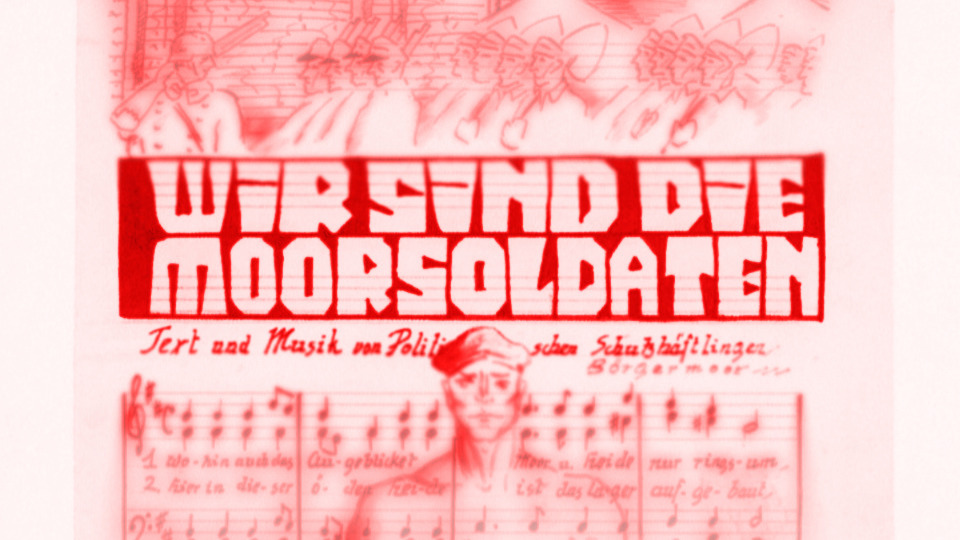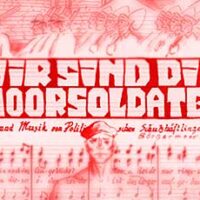
Few of the hundreds of songs in the antifascist repertoire became as popular as the “Song of the Peat Bog Soldiers,” written 90 years ago at the Börgermoor concentration camp. This is its history.

The rise of German fascism prompted an impressive musical culture directed against it. Ironically, if it had not been for the persecutions, the terror, and the crimes of the Nazis, a whole chapter of 20th-century music history would not exist. The 1943 Warsaw Uprising brought us Hirsh Glik’s “Zog nit keynmol,” written in the Vilnius ghetto; the Dachau concentration camp inspired “Dachaulied” by Jura Soyfer and Herbert Zipper, and so forth.
Yet few of the musical pieces written in the Nazi concentration and extermination camps, in the ghettos, or in the anti-fascist resistance became as popular as the “Song of the Peat Bog Soldiers” (in German, “Lied der Moorsoldaten”) written in 1933 at the Börgermoor concentration camp. The song’s 90th anniversary is a good excuse to look at its origins, its spread, and how the memory of the camp hymn has been preserved in the place where it was born.
Circus Konzentrazani

After the transfer of power to Adolf Hitler on January 30, 1933, the new Reich Chancellor immediately formulated his first political goal: crushing the organized labor movement and its real and perceived environment. The burning of the Reichstag building in Berlin on the night of February 27-28 provided an opportunity to put that program into practice. In the following months, tens of thousands of communists, social democrats, trade unionists, and intellectuals were arrested and deported. The legal basis for the persecutions was a decree issued on February 28 and signed by Reich President Paul von Hindenburg, Hitler, Interior Minister Wilhelm Frick, and Justice Minister Franz Gürtner. It indefinitely suspended fundamental rights, including the right to freedom of expression and freedom of the press, and empowered the state to take anyone into “protective custody” without trial for an indefinite period of time. In a sense, it was the founding document of the new state.
Starting in March, the large number of arrests prompted the establishment of the first concentration camps at Osthofen, Dachau, Oranienburg, Breitenau, Sonnenburg, Moringen, Sachsenburg, Lichtenburg and elsewhere. They were located in unused factories, castles, penitentiaries, prisons and other buildings, even a ship. The first concentration camps with wooden barracks were built in the vast moorlands of the Emsland, Börgermoor, Esterwegen, and Neusustrum. They were projected to house up to 5,000 prisoners, the majority of whom, according to reports in the local press, would be used for “cultivation and road work.” The poverty-stricken region in the northwest of the German Reich was made to believe the camps would provide a great future, as the prison labor would improve life for the local population. What the National Socialist propaganda calls “cultivation”—the extraction of peat, the shifting of the peat soil, its preparation for agriculture, the construction of paths, roads or canals—meant ruthless forced labor for the prisoners. With little more than spades, they were expected to transform the Emsland moors into farmland and settlement areas.
But the terror of work was only one side of the prisoners’ everyday life in the moors. The inmates, defined as Nazi opponents, were confronted with unpredictable, ideologically incited SS guards, whose mockery, harassment, humiliation, military drills, and excessive violence turned the camps into places of permanent powerlessness, insecurity, and threat. On August 27, 1933, the prisoners of the Börgermoor camp reacted to the feeling of being at the guards’ mercy with the “Circus Konzentrazani,” a cultural program approved by the camp administration, which expected it to make for an entertaining Sunday afternoon.
In fact, the concentration camp circus was an act of short-term collective self-empowerment. The prisoners, calling themselves “Moorsoldaten” (Peat Bog Soldiers), interspersed their show with many ironic allusions to camp life. In addition to distracting them for a few hours from the dreary and violent everyday life in the camp, their performance was also a confident display of cultural superiority in the face of the camp authorities. A highlight of the show were the six stanzas of the “Camp Song of Börgermoor,” performed by a prisoners’ choir. From stanza to stanza, the song’s emotional immediacy, touching simplicity, narrative dramaturgy, catchy melody, and universal message, had an enormous effect on the 900 comrades in the audience.
The text describes the environment of the camp, the harshness and monotony of bog work carried out with the simplest of equipment, the daily routine that is always the same, the painful longing for family, and the life-threatening conditions of imprisonment, culminating in the sixth stanza, which expresses the hope for an end to imprisonment—but which at the same time can be understood as a general expectation of the future: the end of Nazi rule. All of it sung before the camp commander and 60 guards.
The camp song was written by three communists: the miner Johann Esser (1896-1971), the actor Wolfgang Langhoff (1901-1966), and Rudi Goguel (1908-1976), a commercial employee. Langhoff had had the idea, Esser had found the appropriate words, and Goguel had composed the melody. According to various sources, Langhoff slightly edited Esser’s text before the premiere. Officially, the song was banned almost immediately. But as a camp and freedom hymn, soon titled “Die Moorsoldaten” or “Lied der Moorsoldaten,” it had long since taken root in the hearts and minds of the prisoners. There was no way to stop the song from making its way out of the camp through releases and transfers and then halfway around the world.

An Anti-Fascist Protest Song
In 1935, meanwhile, Wolfgang Langhoff, who was living in Switzerland, published his book Die Moorsoldaten. 13 Months in a Concentration Camp, in which he describes the song’s genesis and the “Circus Konzentrazani” in detail. Seven translations followed the same year. The American edition appeared as Rubber Truncheon with a foreword by Lion Feuchtwanger. Even before that, the lyrics to the song had been published by several foreign newspapers. From 1936 onward, the song also found its way into many other camps of the Nazi regime, including Sachsenhausen and Buchenwald. In 1944-45 it was also sung by German inmates in the POW camps of the U.S. Army.
Among the exiles from Nazi Germany, the camp hymn from Börgermoor developed early on into an anti-fascist protest song. In early 1935, the composer Hanns Eisler (1898-1962) became acquainted with the song in London, where he arranged the melody for the singer Ernst Busch (1900-1980). With a reduced, three-stanza version of the song in his luggage, Eisler traveled to the USA, where from February 1935 on, he included it in his repertoire for a longer concert and lecture tour, where it was most often sung by the Jewish baritone Mordecai Bauman (1912-2007), his constant companion on the tour. The song immediately became popular in the anti-fascist and left-wing cultural scene in the USA. Its spread was spurred on by the rapid translation into English, written by Victor Jerome (1896-1965), to whose adaptation all three-verse English-language recordings of the song can be traced back to this day.

In Europe, too, the song’s journey continued apace. Ernst Busch traveled to the Soviet Union and sang it on the radio there. In January 1936, he made the first recording of the song in Moscow. In December 1937, in the midst of the Spanish Civil War, he cut another recording in Barcelona. During the Spanish war, the song was sung by the International Brigades and, famously, by the African-American singer and actor Paul Robeson (1898-1976). During his performances in Spain, he sang Jerome’s English version, but he often performed the last verse in German, too. As “Chant des Marais,” the song found its way into the canon of the French Résistance during the Second World War. Adaptations in Italian (“Il Canto dei Deportati”), Dutch (“De Veensoldaten,” “De Moerbrigade”), Spanish (“Los Soldados del Pantano”) and Yiddish (“Zumpland”) are also known.
After 1945, the song became entangled in new controversies. During the Cold War, it was largely suppressed, concealed, or overlooked in West Germany. In the GDR, by contrast, where an anti-fascist thread was constructed from the Nazi concentration camps to the communist resistance and the “real socialist” present, it became part of the national identity. Today, the song is part of the program of commemorative events in Germany; in addition, it continues to be sung as a protest song or functions as a workers’, folk, peace, or scout song, depending on its political and cultural purpose.
Archive and Remembrance

In 1985, the small northwestern German town of Papenburg saw the opening of the “Documentation and Information Center Emsland Camps.” It was run by a civil society association founded in 1981, with the ideological support of former prisoners still alive at the time. Not everyone in the region welcomed the new institution. After all, it pursues an unmistakable intention: the reappraisal and mediation of the history of the moor camps, which until 1945 included a total of 15 sites with different functions and responsibilities, but which were forgotten and suppressed for decades. In addition to the search for the remains of the demolished camps, the Center has been engaged in interviewing former prisoners, and inviting them to meetings in Papenburg; collecting written and physical testimonies from the camp period; publishing books and designing educational programs for schools. Due to its national and international fame, the “Song of the Peat Bog Soldiers” has developed over the years into one of the focal points of the archive and its remembrance work.
Today the Center, housed since 2011 in the newly built Esterwegen Memorial, has archived hundreds of recordings of the song, including rarities from private hands, many recordings from the former GDR and, of course, the classics by Ernst Busch, Paul Robeson, Pete Seeger, The Highwaymen, Theodore Bikel, and the Irish Dubliners. Taken as a whole, the collection includes interpretations crisscrossing all musical genres and styles: folk, rock, pop, punk, metal, jazz, classical and avant-garde, soloists, duos, bands, choirs, chapels, and orchestras—everything is represented. In addition to sound-based media (shellac records, vinyl albums, vinyl singles, compact discs, music cassettes, and files), the collection also includes reference books, commemorative literature (for example, all the German-language and international editions of Langhoff’s book “Die Moorsoldaten”), songbooks, original and reproduced song sheets, prisoners’ letters, and other sources.
Based on its own audio collection, supplemented by recordings from the German Radio Archive DRA (Deutsches Rundfunkarchiv), in 2000 the Center published a comprehensive CD edition on the history of song. It was quickly sold out. Due to constant demand, a new edition followed in 2008. Meanwhile, the artistic examination of the hymn from the Börgermoor concentration camp has continued diligently with diverse results. In 2022 alone, almost 60 releases were added to the collection, including reissues, but in the majority more recent recordings.
Clearly, the song refuses to be treated merely as a museum module. Apparently possessing an inner resistance that prevents its loss of substance, it has been on the move for 90 years. There is no one legitimate re-interpretation. Today, every new artistic adaptation of the song inevitably enters a wide field of tension between musical genres and canonizations, between historical distance and empathetic approach, between aesthetic analysis and political message. Documenting the experiences of prisoners, affirming the solidarity of the imprisoned and humiliated, and expressing the hope of overcoming their situation while not coming across as a formulaic party slogan, the “Song of the Peat Bog Soldiers” possesses a universal and visionary core that challenges us time and again, even 90 years after it was first written.
Translated from the German by Sebastiaan Faber. Reposted by permission of the author from The Volunteer (May 18, 2023), with slight changes to conform to PW formatting and style.
We hope you appreciated this article. At People’s World, we believe news and information should be free and accessible to all, but we need your help. Our journalism is free of corporate influence and paywalls because we are totally reader-supported. Only you, our readers and supporters, make this possible. If you enjoy reading People’s World and the stories we bring you, please support our work by donating or becoming a monthly sustainer today. Thank you!







Comments